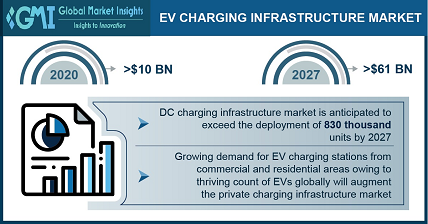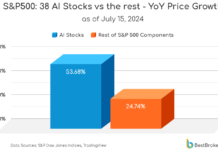
The global EV charging infrastructure market has witnessed considerable expansion over the past years, largely supported by increasing awareness among consumers regarding energy-efficient transportation and supportive government policies like fiscal benefits, tax rebates, and grants to promote EV adoption.
Growing dependency on electric automobiles and buses over diesel variants due to the reduced emissions and smoother, more quiet transit will support the business scenario further.
Reports claim that global EV charging infrastructure market size could surpass an annual value of USD 61.9 billion through 2027.
Major market players and EV companies are collaborating with one another with an aim to reduce carbon emissions and develop more energy-efficient vehicle makes. Both private and public companies are making robust investments to develop EV charging infrastructure and incentivize EV buyers.
EV charging infrastructure companies are diligently working on new products and solutions. For instance, in 2019, Nissan introduced its new electric vehicle charging service, known as the Nissan Charge, designed to enhance EV ownership experience. The new service provides users access to over 100,000 charging points across Europe along with features such as multiple payment options and personal web portals, among others.
Some of the trends that may propel EV charging infrastructure industry
- Robust demand for private EV charging stations
There is an increasing demand for EV charging stations across residential and commercial areas on account of a rise in purchase of EVs lately. Changing preference of end-users towards the usage of environmentally friendly transit alternatives as well as the availability of the fiscal incentives on the installation of EV charging stations is expected to boost the private EV charging infrastructure industry outlook. New product deployments are likely to be witnessed with more technical innovations such as mobile app launches to manage EV charging.
- Promising outlook for DC charging infrastructure
The DC charging infrastructure segment is expected to surpass the deployment of 830 thousand units in the upcoming years credited to the current digitization and rising focus on the installation of EV charging stations. These systems are getting upgraded with an aim of making the charging process faster and easier and enhancing production, storage, and energy management. In addition, there is a growing need to deploy DC fast and ultrafast stations which comprise of CHAdeMO & tesla superchargers.
- Chile emerging as a lucrative business ground
The government in Chile is focusing more on large-scale adoption of electric vehicles and the quick development of EV charging infrastructure in line with their Sustainable Development Goals (SDGs). Furthermore, surging GHG emissions and its threat against the environment is forcing authorities to take significant steps to decrease emission levels. According to the World Economic Forum, the Chilean government has put forth its view on electric vehicles to account for 40% of the country’s private transportation and 100% of its public fleet by the year 2050.
Source – https://www.gminsights.com/industry-analysis/ev-charging-infrastructure-market

















